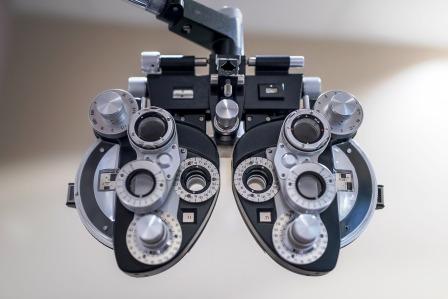
Researchers from the NIHR Southampton Biomedical Research Centre are trialling the use of a new, at-home iPod-like device to detect changes in a patient’s vision that could suggest the early development of age-related macular degeneration, known as AMD.
Professor Andrew Lotery, a University of Southampton eye expert from the BRC, is leading the Southampton-arm of this national study that requires patients to use a handheld device and an app to track their vision, then record their results. Participants will still receive normal care provisions in the hospital clinic, in the hope that at-home monitoring will detect the development of the disease early and trigger treatment.
Age related macular degeneration
AMD is a common eye condition that is the leading cause of vision loss among people ages 50 and older. It is a complex, inherited and diverse disease that damages the macula – a small spot near the centre of the retina – that is responsible to the detailed central vision and allows us to see objects straight ahead.
There are three stages of the condition – early, intermediate and late – but not everyone with early AMD will go on to develop late AMD. Currently, there is no way for doctors to tell who will develop the sight-threatening late stage of the disease, as some patients progress slowly or not at all, whilst others deteriorate at a rapid rate.
Spotting signs early on
Research has shown that treatment of the disease is far more successful when it is caught in its early stages. Participants will be recruited from current hospital clinics and will have already developed the disease in one eye. The study is aiming to detect deterioration in the second eye so treatment can be started at the earliest point.
Each participant will use the handheld device at home, much like an iPod, to play a game which requires a good level of vision. Taking the test weekly, the results are then recorded and compared to averages to spot any deterioration in vision.
Patients will still be seen in clinic to ensure that treatment of the disease is maintained but it is hoped that the at-home testing will reduce the need for frequent hospital visits.
“We currently treat about 1,000 patients a week in clinic for AMD. It is the most common cause of sight loss in the elderly in the Western world,” explained Professor Lotery, who is also a consultant ophthalmologist at the University Hospital Southampton NHS Foundation Trust.
“There are no negatives to this study. It is an additional monitoring aid that we can use to ensure that the best treatment is given to our patients. We hope that this will be a good way of monitoring vision and will be used on a broader scale in the future.”
Notes:The MONARCH study is funded by National Institute of Health Research (NIHR) Health Technology Assessment Programme (HTA) (15/97/02). The views and opinions expressed therein are those of the authors and do not necessarily reflect those of the HTA programme, NIHR, NHS or the Department of Health and Social Care. The study is Sponsored by Queen’s University of Belfast and is managed by the Clinical Trials and Evaluation Unit at the University of Bristol. This study is kindly supported by:Visumetrics AB in collaboration with Novartis Sverige AB have provided use of the MultiBit vision test software application free of charge for the duration of the study; Vital Art and Science LLC have provided use of the MyVisionTrack® vision test software appplication free of charge for the duration of the study, and KeepSight have provided access to KeepSight branded vision monitoring and education tools and use of the KeepSight Journal, adapted for UK use for the duration of the study. For more information about MONARCH please contact the MONARCH study coordination team on 0117 34 22526 or email: MONARCH-study@bristol.ac.uk
Posted on Wednesday 26 September 2018